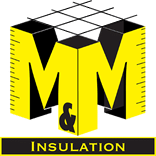FAQs
FREQUENTLY ASKED QUESTIONS
Our closed-cell foam product has an effective R-Value of 7.0 per inch. Spray foam is the only insulation product that offers a true R-value because it is the only product that creates an air seal. Don’t get caught up in the Myth of R-values. R-value means nothing without a true thermal air seal. Only spray-foam achieves this.
We provide a sealed thermal envelope. When applied, the insulation conforms and fills each cavity, crevice and void. M&M Insulation contributes to the overall comfort and health of the occupants of a home because there are no fibers or “clumps” of loose matter. By reducing air infiltration, the insulation also reduces dust and harmful, household mold and mildew. M&M Insulation provides a healthier, draft-free, indoor environment with no harmful emissions that can cause allergic reactions.
Most damaging moisture within a building envelope cavity is the result of warm moist inside air being exchanged with the cold dry air inside an insulation cavity. As the moisture in the air condenses, it forms dew within the insulation. Because foam insulation is an air seal, this moisture movement and condensation does not occur. It is ideal for use in climates where buildings are both heated and air conditioned because the situation is reversed in summer with moisture forming on the back of the interior vapor retarder.
The Spray Foam insulation is sprayed into place onto a studded wall by certified M&M professionals. As with any open surface, the foam insulation can be sprayed once electrical and plumbing services are in place. It then expands to up to 100 times its initial volume in seconds, permanently adhering to the surfaces of the surrounding building materials and sealing all gaps.
No, foam insulation has been thoroughly tested and is not a concern to electrical authorities nor is it corrosive to any metals whatsoever.
Our product offers no food value. It is an inert substance; therefore it does not support bacteria or fungal growth whatsoever.
Indefinitely. As an inert, long lasting polymer, any residential or commercial structure is a great place for our insulation.
- Fiberglass batts will not stop air leakage (they might filter out some dirt and dust). Blown-in cellulose will slow down air leakage. Spray-foam will stop air leakage . . . dead. Spray-foam is also mold & moisture resistant unlike fiberglass & cellulose.
- Fiberglass batts have an R-value of about 3.5 (1-inch thickness) but this is not a true R-value since there is no air seal. Blown-in cellulose has an R-value of about 3 to 4 (1-inch thickness) but also no air seal. Our spray-foam has a true R-value of 3.8 – 6.8 depending on the density foam we use (1-inch thickness).
- Fiberglass batts can sag over time; blown-in cellulose can settle over time: both situations leave sections uninsulated and you’ll feel warmer or colder because of it. Spray-foam completely adheres to wood and sheathing; the result is a permanent barrier to heat loss and air entry.
- Spray-foam will add strength and rigidity to your house. Fiberglass batts & blown-in cellulose will not.
No. Our foam insulation is an inert substance so it is pest resistant. There is absolutely no food value to the insulation.
For new construction or renovations, the insulation is installed after the windows, doors and roof systems are in, the electrical, framing and plumbing inspections are complete, and after any other electrical or mechanical system located behind the drywall is installed. It is the last installation to take place before drywall installation. On existing homes, the spray foam insulation can be installed to the attic, roof line, and sub-flooring to seal in the house. It is more cost effective to leave existing interior wall insulation in place.
An outlet can be easily added since the spray foam insulation drills more easily than wood.
Everyone from cutting edge building scientists, engineers, insulation experts, Green Home specialists, mold experts, etc recommend the use of spray foam in new contruction or renovations.
Spray foam has been around for more than 30 years for commerical & industrial uses. It has gotten very popular for residential use in the last 10 years.
Your house DOES need to be ventilated, BUT most home engineers & building scientists (as well as the US Dept of Energy) advise that you seal the structure as tight as possible & provide necessary ventilation through your air conditioning & heating system. Many systems employ an “air exchanger” which pre-conditions incoming outside air to control humidity & energy efficiency. This type of design along with spray-foam creates a true Thermal Envelope.
CONTACT
SEND US A MESSAGE!
Choose M&M Insulation
With our expert knowledge, long-standing reputation for superior quality and competitive pricing, we stand behind the products and our work. So, contact us today at 952-240-6057 and maximize your Minneapolis home’s comfort and energy efficiency.
